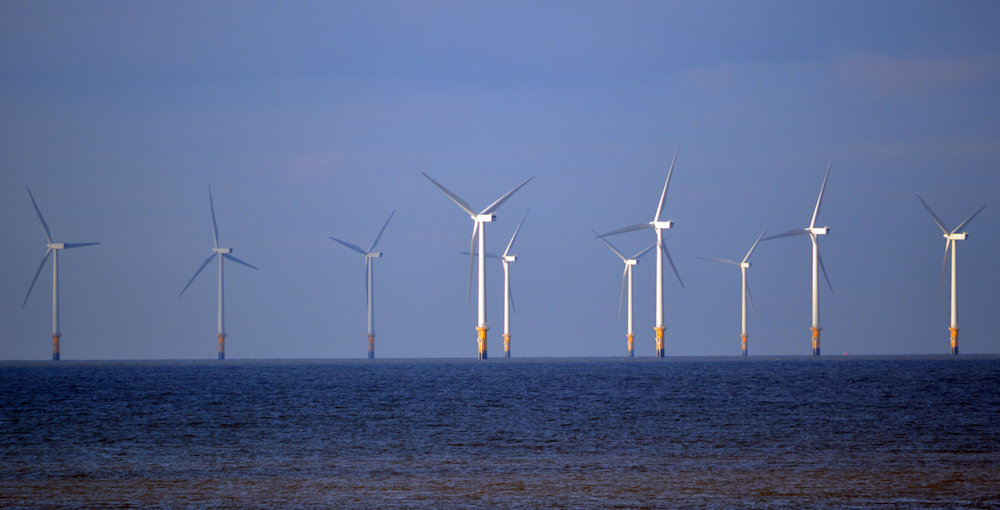“A fiber cable has a glass core that allows you to send an optical signal down at the speed of light; when there is any vibration, strains, or stresses or changes in temperature of the material that is being monitored, that information will be carried in the light signal that is scattered back,” said Berkeley Lab scientist Yuxin Wu, who is leading both projects.
The California Energy Commission has awarded Berkeley Lab $2 million for the offshore wind project and $1.5 million for the natural gas project. Both projects are in collaboration with UC Berkeley, and for the natural gas project, Berkeley Lab will also collaborate with PG&E, Schlumberger, and C-FER Technologies (a Canadian company), to carry out the tests.
From gearbox failure to humpback whale movements
Europe is at the forefront of offshore wind development. Other parts of the world are only in the early stages of commercialization, but it is growing quickly, including in the U.S., where the Department of Energy (DOE) has been supporting development of the technology. Offshore wind resources in the U.S. are abundant and have the potential to provide nearly double the total amount of electricity currently generated in the U.S., according to a 2016 DOE report.
One of the advantages of offshore wind for the U.S. is that the resource is close to dense coastal populations. Therefore, energy transmission is a lesser challenge compared to other renewable energy sources such as onshore wind and solar farms, which are typically located farther away from population centers due to the availability and cost of real estate.
Off the California coast, the ocean floor drops off steeply, making floating wind turbines – which are tethered to the ocean floor by mooring chains, unlike conventional “fixed bottom” offshore wind turbines – the only viable option. But this technology faces several obstacles, including how to do maintenance and operations on remote installations in the ocean economically and how to monitor if hazards such as earthquakes or extreme weather conditions disrupt operations.
This is where the fiber optic cables come in.
“One of the most expensive components of a wind turbine is the gearbox; they also tend to be the part that’s most vulnerable to failure,” said Wu, who is also head of Berkeley Lab’s Geophysics Department. “Often before they fail they produce abnormal vibrations or excessive heat due to increased or irregular friction. We intend to use fiber optic cables to monitor the vibrational, strain, and temperature signal of the gearbox, in order to pinpoint where problems are happening.”
Wrapping fiber optic cables around the entire gearbox can provide a 3D map of changes with resolution at the millimeter scale. “It could help identify problems with the gearbox at an early stage, which would trigger emergency management, before a catastrophic failure causing loss of the whole turbine,” Wu said.
What’s more, Wu said the project intends to explore how the fiber optic cables can be used to detect marine mammal activity. The sensitivity of the fiber signal could allow for differentiation between, say, crashing waves and a pod of whales swimming by.
“Environmentally sustainable development of offshore wind is critical,” he said. “With a large offshore wind farm, there would be many of these mooring lines securing the turbine structures to the ocean floor. If a humpback whale swims by, what are the impacts of these mooring lines on their activities? Will the whales generate unique vibrational signals that can be picked up by the fiber optic sensors? If we can track the signals of a whale swimming by, it will allow us to evaluate whether and how the offshore wind turbine impacts marine mammals.”
Wu added that he is looking to learn more about whales and other marine mammals from marine biologists and also seeking a partner to collaborate with to test the sensors in the ocean.
Making underground gas reservoirs safer
Similarly, Wu and his research partners hope to use fiber optic cables to monitor the boreholes of underground natural gas storage reservoirs. The borehole is used to inject and withdraw gas from vast underground storage reservoirs. Like any pipe, these boreholes degrade and corrode over time. The massive gas leak at Aliso Canyon in 2016, in which thousands of families had to evacuate their homes, was concluded to be caused by corrosion damage of the borehole.
Thus, borehole integrity is of paramount importance to safe storage of natural gas in the subsurface. It is currently monitored mostly using tools that are intrusive, expensive, and incapable of providing frequent, real-time data. “It is difficult to predict borehole degradation trajectory with the sparse data generated by traditional methods. Having higher frequency datasets covering the entire borehole is key to provide an early warning of potential borehole failures,” Wu said.
In the new CEC-funded project, Berkeley Lab will work with UC Berkeley, PG&E, Schlumberger, and C-FER to test a novel suite of technologies for autonomous real-time monitoring using two methods, one based on distributed strain, vibration, and temperature sensing in fiber optic cables and the other using electromagnetic wave reflectometry.
EM-TDR (or electromagnetic time domain reflectometry) is similar to the fiber optic technology except that it uses longer wavelength electromagnetic waves instead of visible light (also an electromagnetic wave but at much short wavelength) as signals. “EM-TDR sends electromagnetic waves into an electronically conductive material, and when there is a change due to damage, such as corrosion, you get an EM signal back which can help you identify corrosion or other degradations,” Wu said.
And because the borehole is made of steel, which is electrically conductive, no downhole equipment will need to be installed. Thus, EM-TDR is very easy to deploy and can be used under many circumstances that prevent the use of other types of sensors. On the other hand, EM-TDR is still an early-stage technology; this new project will allow further testing and development.
For both the offshore wind and natural gas projects, the scientific challenge, Wu said, is optimizing the technology design and sensitivity and developing real-time edge computing technologies. “In addition to using commercial systems, our team is developing new fiber interrogators that will allow us to not only get to the original raw data but also play with the physics to better design a system that can give us the most sensitive signal we want,” he said. “In addition, we will be developing machine learning-based edge computing methods to turn raw data into actionable intelligence quickly. This is key for real-time monitoring.”
# # #
Founded in 1931 on the belief that the biggest scientific challenges are best addressed by teams, Lawrence Berkeley National Laboratory and its scientists have been recognized with 13 Nobel Prizes. Today, Berkeley Lab researchers develop sustainable energy and environmental solutions, create useful new materials, advance the frontiers of computing, and probe the mysteries of life, matter, and the universe. Scientists from around the world rely on the Lab’s facilities for their own discovery science. Berkeley Lab is a multiprogram national laboratory, managed by the University of California for the U.S. Department of Energy’s Office of Science.
DOE’s Office of Science is the single largest supporter of basic research in the physical sciences in the United States, and is working to address some of the most pressing challenges of our time. For more information, please visit energy.gov/science.
Related articles:
Underwater Telecom Cables Make Superb Seismic Network
Dark Fiber Lays Groundwork for Long-Distance Earthquake Detection and Groundwater Mapping
Original post https://alertarticles.info



